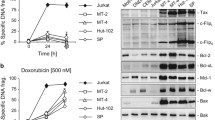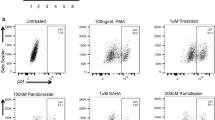Abstract
The transition from interleukin-2 (IL-2)-dependent to IL-2-independent growth is considered one of the key steps in the transformation of human T-cell leukemia virus type-I (HTLV-I)-infected T cells. The expression of thioredoxin-binding protein-2 (TBP-2) is lost during the transition of HTLV-I-infected T-cell lines. Here, we analysed the mechanism of loss of TBP-2 expression and the role of TBP-2 in IL-2-dependent growth in the in vitro model to investigate multistep transformation of HTLV-I. CpGs in the TBP-2 gene are methylated in IL-2-independent but not in IL-2-dependent cells. Sequential treatment with 5-aza-2′-deoxycytidine and a histone deacetylase inhibitor augmented histone acetylation and TBP-2 expression, suggesting that loss of TBP-2 expression is due to DNA methylation and histone deacetylation. In IL-2-dependent cells, a basal level of TBP-2 expression was maintained by IL-2 associated with cellular growth, whereas TBP-2 expression was upregulated on deprivation of IL-2 associated with growth suppression. Overexpression of TBP-2 in IL-2-independent cells suppressed the growth and partially restored responsiveness to IL-2. Knockdown of TBP-2 caused the IL-2-dependent cells to show partial growth without IL-2. These results suggested that epigenetic silencing of the TBP-2 gene results in a loss of responsiveness to IL-2, contributing to uncontrolled IL-2-independent growth in HTLV-I-infected T-cell lines.






Similar content being viewed by others
References
Butler LM, Zhou X, Xu WS, Scher HI, Rifkind RA, Marks PA et al. (2002). Proc Natl Acad Sci USA 99: 11700–11705.
Cameron EE, Bachman KE, Myohanen S, Herman JG, Baylin SB . (1999). Nat Genet 21: 103–107.
Chen KS, DeLuca HF . (1994). Biochim Biophys Acta 1219: 26–32.
Coombes MM, Briggs KL, Bone JR, Clayman GL, El-Naggar AK, Dent SY . (2003). Oncogene 22: 8902–8911.
Gardiner-Garden M, Frommer M . (1987). J Mol Biol 196: 261–282.
Goldberg SF, Miele ME, Hatta N, Takata M, Paquette-Straub C, Freedman LP et al. (2003). Cancer Res 63: 432–440.
Han SH, Jeon JH, Ju HR, Jung U, Kim KY, Yoo HS et al. (2003). Oncogene 22: 4035–4046.
Holmgren A . (1985). Annu Rev Biochem 54: 237–271.
Jeang KT, Giam C, Majone F, Aboud M . (2004). J Biol Chem 279: 31991–31994.
Maeda M, Shimizu A, Ikuta K, Okamoto H, Kashihara M, Uchiyama T et al. (1985). J Exp Med 162: 2169–2174.
Maeda M . (1992). Hum Cell 5: 70–78.
Makino S, Masutani H, Maekawa N, Konishi I, Fujii S, Yamamoto R et al. (1992). Immunology 76: 578–583.
Masutani H, Yodoi J . (2002). Methods Enzymol 347: 279–286.
Matsuoka M . (2003). Oncogene 22: 5131–5140.
Migone TS, Lin JX, Cereseto A, Mulloy JC, O'Shea JJ, Franchini G et al. (1995). Science 269: 79–81.
Morgan DA, Ruscetti FW, Gallo R . (1976). Science 193: 1007–1008.
Nishinaka Y, Nishiyama A, Masutani H, Oka S, Ahsan MK, Nakayama Y et al. (2004a). Cancer Res 64: 1287–1292.
Nishinaka Y, Masutani H, Oka S, Matsuo Y, Yamaguchi Y, Nishio K et al. (2004b). J Biol Chem 279: 37559–37565.
Nishiyama A, Matsui M, Iwata S, Hirota K, Masutani H, Nakamura H et al. (1999). J Biol Chem 274: 21645–21650.
Nosaka K, Maeda M, Tamiya S, Sakai T, Mitsuya H, Matsuoka M . (2000). Cancer Res 60: 1043–1048.
Okamoto T, Ohno Y, Tsugane S, Watanabe S, Shimoyama M, Tajima K et al (1989). Jpn J Cancer Res 80: 191–195.
Satoh A, Toyota M, Itoh F, Sasaki Y, Suzuki H, Ogi K et al. (2003). Cancer Res 63: 8606–8613.
Spencer VA, Sun JM, Li L, Davie JR . (2003). Methods 31: 67–75.
Tagaya Y, Maeda Y, Mitsui A, Kondo N, Matsui H, Hamuro J et al. (1989). EMBO J 13: 2244.
Uchiyama T, Yodoi J, Sagawa K, Takatsuki K, Uchino H . (1977). Blood 50: 481–492.
Ushijima T, Okochi-Takada E . (2005). Cancer Sci 96: 206–211.
Yasunaga J, Taniguchi Y, Nosaka K, Yoshida M, Satou Y, Sakai T et al. (2004). Cancer Res 64: 6002–6009.
Yodoi J, Takatsuki K, Masuda T . (1974). New Engl J Med 290: 572–573.
Yoshida M, Miyoshi I, Hinuma Y . (1982). Proc Natl Acad Sci USA 79: 2031–2035.
Acknowledgements
We thank Dr Koichi Ikuta for discussions, and Ms Yoko Kanekiyo and Ms Satoko Maeji for secretarial assistance. This work was supported by a grant-in-aid for scientific research from the Ministry of Education, Culture, Sports, Science and Technology of Japan and by the Research and Development Program for New Bio-Industry Initiatives.
Author information
Authors and Affiliations
Corresponding author
Rights and permissions
About this article
Cite this article
Ahsan, M., Masutani, H., Yamaguchi, Y. et al. Loss of interleukin-2-dependency in HTLV-I-infected T cells on gene silencing of thioredoxin-binding protein-2. Oncogene 25, 2181–2191 (2006). https://doi.org/10.1038/sj.onc.1209256
Received:
Revised:
Accepted:
Published:
Issue Date:
DOI: https://doi.org/10.1038/sj.onc.1209256
- Springer Nature Limited
Keywords
This article is cited by
-
Tumor necrosis factor induces rapid down-regulation of TXNIP in human T cells
Scientific Reports (2019)
-
Development of a novel cell-based assay system EPISSAY for screening epigenetic drugs and liposome formulated decitabine
BMC Cancer (2013)
-
Molecular characterization of differentially expressed TXNIP gene and its association with porcine carcass traits
Molecular Biology Reports (2012)
-
Thioredoxin-binding protein-2 (TBP-2/VDUP1/TXNIP) regulates T-cell sensitivity to glucocorticoid during HTLV-I-induced transformation
Leukemia (2011)
-
Inhibition of Histone Deacetylase 10 Induces Thioredoxin-Interacting Protein and Causes Accumulation of Reactive Oxygen Species in SNU-620 Human Gastric Cancer Cells
Molecules and Cells (2010)




